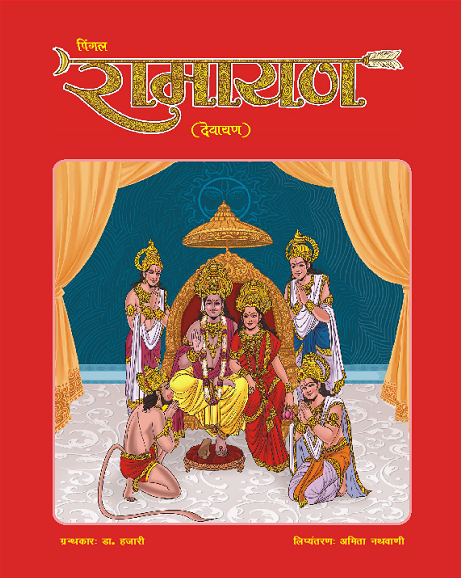Pingal Ramayana - Sub-category to Vol II and III
Pingal Ramayana is an integral part of the published epic, Devayan. It is included in the Ram Mandala of the epic, particularly the Ramayana Varga that is spread over the second and third volumes of the great epic, published in the years 2002 and 2004. Now, just as the Sri Ram temple in Ayodhya is about to be constructed, Pingal Ramayana, transcribed into Devanagari, will be published, if the Divine wishes, as a single volume.
This epic Ramayana, like the others also consists of seven Kandas – the Bal Kanda, the Ayodhya Kanda, the Aranya Kanda, the Kishkindha Kanda, the Sundara Kanda, the Lanka Kanda and finally the Uttara Kanda. However, as the Dashrath Varga preceding the Ramayana Varga provides the earlier history and the foundation of the epic, I have decided to include it in this epic. Pingal Ramayana is approximately 800 pages long and consists altogether of 276 sargas. It is an original work narrated to Dr. Hajari, a young Bengali Homeopathic Doctor, a devotee in the early 1950s in the Sri Aurobindo Ashram in South India, thus making it the most recent version of Ramayana.
Pingal Ramayana is unique and remarkably interesting in its narration. It provides the background of the cosmic cycle of time and the play therein of the hidden forces of nature, that try to control the course of events and even succeed in the short term. The roles played by the negative forces of Kali, Shani, and Shukracharya in the background driving the sudden and incredible turn of events in Sri Ram’s life are explained in detail.
Many hitherto mysteries not adequately elucidated elsewhere are also narrated that include the stories of earlier adventures of King Dasharatha and his many marriages, performed mainly to provide protection to the girls from the clutches of Ravan.
The Ram Mandala of Devayana actually begins with the Gods, who while suffering untold miseries under the suzerainty of Ravana, approach Lord Brahma and then Lord Vishnu for obtaining relief. Knowing about the impending incarnation of Lord Vishnu in the mortal world, they followed his instructions to empower the great monkey kingdom of Kishkindha with their force. The Gods - Surya, Indra, Brihaspati, and Vayu respectively gave their strength to Bali, Sugriv, Jambavan, and Hanuman. Varuna also contributed to the birth of the twins, Nal and Neel. And it was Dhanwantari who used his power to father Sushena in the house of the royal healer of the kingdom of Kishkindha, who later on becomes instrumental in healing Lakshman and bringing him back to life during the great battle of Lanka.
An interesting event is that when Rishi Narad brings the painful news of the earth to Lord Vishnu, he manifests himself four times, one of them contains himself, while the other three have parts of his essence. On the earth, this results in the birth of Sri Rama and his three brothers – Bharat, Lakshman and Shatrughana as the three queens, Kaushalya, Kaikeyi and Sumitra have the four boys, as the Charu that came from the yajna was divided amongst them, with Sumitra receiving a double portion. Similarly, the Goddess Lakshmi, also manifests fourfold. One is Sita and the other three are her cousins – Madhvi, Urmila, and Shrutkirti. They are married at the same time when Sri Ram marries Sita. On the earth the results manifest according to whatever the Gods have already decided upon.
An important event is how the King Janaka receives Shiva’s immense bow from Rishi Bhrigurama, and how he is instructed to give his daughter Sita, only to that person who could pick the bow in his hands and put the string on it. This bow was so huge that the strongest warriors could not even lift it.
In the Ayodhya Kanda, we see additionally how Shani plays a significant role, disguised as an accomplished astrologer, where he meets Manthara and through her, Queen Kaikayi. He tells them that according to the stars it would be a catastrophe if Sri Rama ascends the throne of Ayodhya. We see how his insidious contribution led to thwarting the coronation of Sri Rama.
During their forced sojourn in the forests, Sri Rama, Lakshman and Sita are accompanied by many Rishis and their sons. They spend very happy times with them and are made aware of many ancient stories that inspire them. They hear about Dhruva. How at the age of five he goes into the forest and starts his spiritual austerity.
In the Lanka Kanda, Vibhishan tells Sri Rama the Devi Mahatmaya, in a concise form while they are preparing to face the mighty Ravan, in order to free Sita from her captivity in the Ashok Vana in Lanka. We see Shani’s role again, in the Uttara Kānda, where he plants doubts in the minds of the general public, maintaining that her purity was in question, as she lived in Ravan’s power for many months. To avoid all these controversies and put an end to disharmony in the minds of the citizens of Ayodhya, Sri Rama ordains Lakshman to take her to the forest under the pretext of showing her the area and leave her near the Valmiki Ashram. Thus she is forced to live in exile for many years in the Ashram bringing up her twin sons, under the guidance of the Rishi.
PURCHASE INFORMATION
Ms. Jyotsna Khandelwal Moonlight Books:- 20 Ekjot Apartment, Pitampura Road, No. 44, Delhi-110034, India.
Email: moonlightbooks@gmail.com
Amita Nathwani nilesh.nathwani@aon.at | amitanathwani@gmail.com


